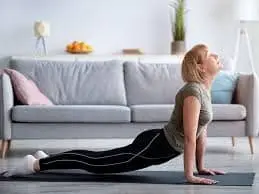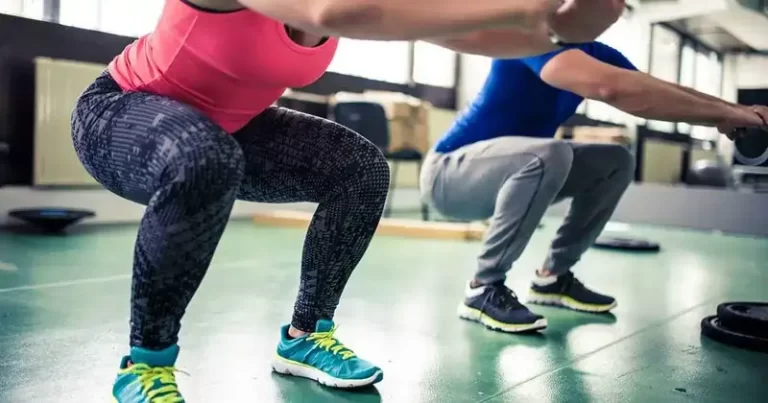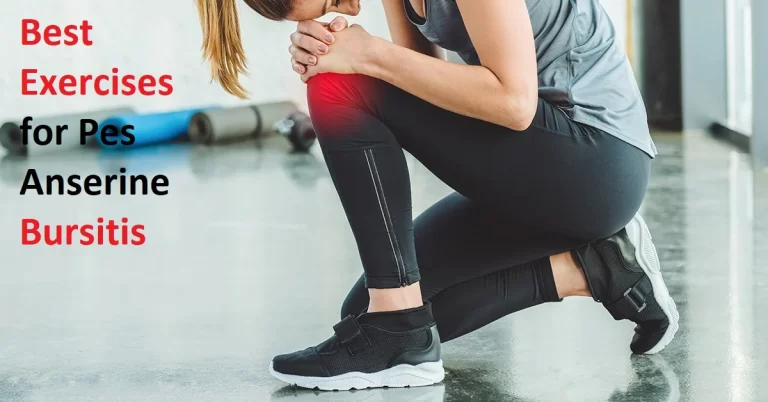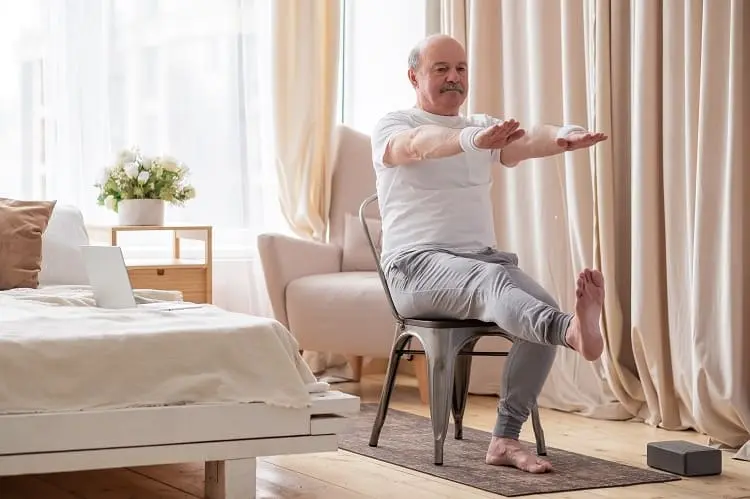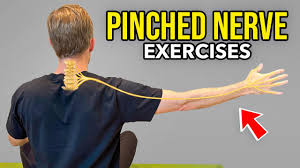Bridging Exercise: Health Benefits, How to Do?
An excellent closed-chain exercise is the Bridging Exercise.
By doing this exercise, you can stabilize your spine and strengthen your hip-back extensor muscles.
It is also recommended that this be done if the patient has back pain.
The Bridge Exercise: What Is It?
By elevating your hips while resting on the floor, the Bridge Exercises strengthen your hamstrings and glutes while stabilizing your core. By making these muscles stronger and more stable, you may move more freely during daily activities and exercise, which will lessen the unwanted strain on the nearby muscles and joints and, eventually, lessen pain.
Since a bridge exercise requires no need for any specialized equipment, it’s a great at-home exercise choice. Things like a yoga mat and towel are required. A simple exercise like the glute bridge can be performed by anyone of any age or fitness level. It can be combined with other lower-body exercises to exactly tone and shape the lower body, or it can be used as a warm-up exercise.
What muscle is used for bridging exercise?
- Gluteus maximus
- Gluteus medius
- Core muscle
- Biceps femoris
- Semitendinosus
Advantages:
The bridge exercise, which stabilizes and strengthens important muscle groups, can help you in many ways with your everyday activities.
These include:
- Core Stability and Strength
Functional mobility is built on a solid core. The transverse abdominis and multifidus are two deep core muscles that improve total core stability and balance during bridging. A stronger core is essential to maintain alignment, prevent falls, and engage in activities requiring deliberate movement.
- Activation of Hip and Gluteal Muscles
Glute strength is essential for walking, getting up from a chair, climbing stairs, and preserving correct alignment when performing different exercises. Patients can improve their functional capacities by strengthening these muscles, giving them more power and control over their lower body.
- Spine Health
The erector spinal muscles, which maintain the rigidity of the spine, are activated by bridging. A solid spine is necessary for everything from lifting heavy objects to doing housework. By bridging, you can reduce the risk of injury while carrying out daily tasks and preserve a healthy spine.
- Step and Motion
Gait and mobility can benefit from the strength that comes with bridging. Patients can move with more confidence and less effort by developing a more efficient and stable gait pattern, which can be achieved by strengthening the hip muscles and improving core stability.
- Avoiding Falls
Bridging has been shown to improve stability and balance, which is especially beneficial for older individuals. Strengthening the lower body muscles, especially the glutes and core, can reduce the risk of falling by increasing response times and providing more control over movements.
How is a Bridging exercise performed?
- Start with a supine lying position on the ground.
- Bend your knees.
- Lift your lower back off the ground and let out a deep breath.
- Keep your thighs and inner feet parallel.
- Positioning yourself from the shoulders to the knees is good with a straight spine.
- You can extend your hands down the floor under you and rest them with your palms down by your sides.
- Hold this position for a few seconds.
- Now lower your back to the ground.
- Then return to your neutral position.
- Then relax.
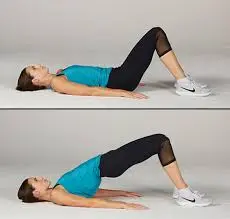
Bridging exercise different formats:
Here are detailed explanations of several sorts of bridge exercises for individuals who are curious about how to perform them.
Bridging exercise with Elevated Feet
One bench and one met are needed for this exercise.
- Begin in a comfortable lying down on the surface of the ground.
- Take a bench and put your heel on it.
- You can lay a little cushion under your head if you want extra comfort.
- Now without flexing your knees lift your body.
- When raising your body upward, maintain a neutral neck position.
- This requires you to inhale deeply.
- For a few seconds, you must stay in this posture.
- Place your body down now, slowly.
- Then return to your neutral position.
- Then relax.
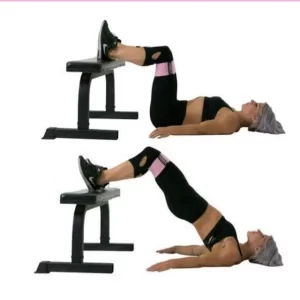
Glute bridge and hamstring curl
- It is best to start by lay down on the ground.
- Put a Swiss ball under your feet.
- The objective is to keep the spine in its neutral position.
- This is where you are to begin.
- Your core will become more firm as you draw in your belly button and spine.
- To lengthen your hips and rest your upper back on the Swiss ball, press your heels into the surface.
- During this exercise, make sure that the majority of your strength comes from your glutes rather than your quadriceps or lower back.
- To bring the Swiss ball in toward you, bend your knees while maintaining an engaged core and raised hips.
- Tightness in your hamstrings should be felt while performing this.
- Step back to the beginning after taking a breath and spreading your legs.
- Then relax.
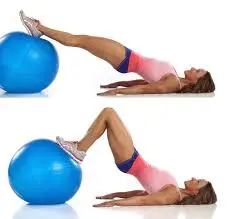
Single-Leg Bridge
For this kind of bridge, no tools are required.
Through this exercise, the hip extensor muscle can be targeted and strengthened.
- This is an activity where you have to lie on your back and place your hands parallel to both sides.
- At this point, you must raise one leg to a height of around 45 degrees above the floor.
- The first step in a single-leg bridge is to raise your hips and back off the ground.
- You may maintain this lift using your abdominals and gluteal muscles until your fingers and shoulders are in a straight line.
- Hold this position for a few seconds.
- Then return to your neutral position.
- Then relax.
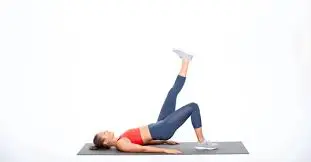
Gluteal Bridge With Marching
Your core muscles will get stronger with these exercises, which will benefit you in daily life and improve your running and sports performance.
- Start with lying down on the floor.
- Bent your both knees.
- This is the starting point.
- Your back and buttocks have to be raised using your core muscles.
- To perform the gluteal bride march, bring your knee up to your chest.
- Hold this position for a few seconds.
- Extending the opposing knee, put the feet back on the floor.
- Then return to your neutral position.
- Then relax.
- Repeat with the opposite knee.
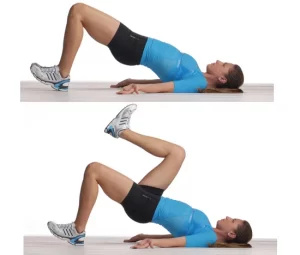
Weighted Glute Bridge Exercise
Once you’ve learned the bodyweight bridge exercise, you can use a weight to challenge your muscles even more.
- The initial step is to get on the flooring and lie down.
- Bend your both knees on the floor.
- Position a dumbbell or kettlebell on your pelvis in the space between your hip bones.
- Let go of the stress, extend your hips, and contract your glutes.
- By the time you finish the exercise, your shoulders should be parallel to the floor.
- Hold for a short time, being mindful that your hips shouldn’t drop and your spine shouldn’t curve or arch.
- Step your hips down to the floor and release a breath.
- Then return to your neutral position.
- Then relax.
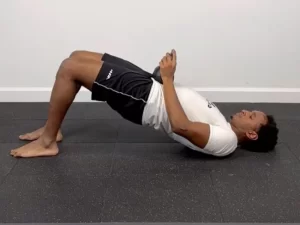
To exercise safely, follow these tips:
- Before exercising, make sure your body is thoroughly warmed up.
- Exercise should be stopped if it hurts.
- To avoid overdoing it and developing sore muscles, gradually increase the number of repetitions and length of your exercise.
- To protect your body from harm and to achieve the desired results, always exercise with the correct form.
- When exercising, try to wear clothing that doesn’t restrict your movement too much. Wear loose clothes instead.
When should you stop doing this exercise?
- The last phases of pregnancy
- Recently given birth
- Recovering after any surgery
- Injuries to your back, abdomen, pelvis, hip joints, ankles, or knees
- Hernia in the abdomen
- Any tingling or burning in the thighs and legs
Most common mistakes:
When doing the fundamental glute bridge exercise, stay away from these posture problems.
- Having Too High of Hips
Stay away from hyperextending your lower back by keeping your hips from rising too high. By keeping your abs tight, you can prevent overriding your back.
- Letting Your Hips Drop
Lower your pelvis to the floor if you are having trouble maintaining the glute bridge position because your hips are lowering. It may only be necessary to hold the bridge posture for a short while initially as you build up more strength.
Summary:
Bridging provides a beneficial supplement to physiotherapy treatment plans, helping patients lay the groundwork for increased functional well-being. Strength, stability, and flexibility are improved with these exercises since they target important muscle areas like the lower back, glutes, and core.
Whether your patients want to walk more confidently, perform daily tasks more easily, or avoid falls, using various forms of bridging can help them achieve their functional goals and lead more independent and active lives.
FAQs
Is practicing bridges daily safe?
You can perform leg bridges daily. You must focus on developing proper posture and technique. A trainer may be necessary who can help you with this process. Additionally, keep in mind that overusing your gluteal muscles will only result in pain.
What negative impacts might bridge exercises have?
It’s the part of the back bridge that poses a risk when your back becomes arched. This hyperextended back puts significant compressive forces on your spine, which can cause damage to the discs that separate your vertebrae. Over time, the strain caused by overextension damages your spine.
Can a bridge help lose tummy fat?
Setu bandhasana, also known as the bridge posture, is a useful asana for toning the core and helping in the reduction of belly fat.
Is practicing bridge difficult?
Glute bridge is an exercise that is effective, challenging, and flexible. Any exercise regimen would benefit greatly from it, regardless of age or degree of fitness.
When should bridging exercises be avoided?
Before you begin an exercise program or incorporate new exercises like glute bridges into your existing strength training regimen, consult your physician. Exercises involving the glute bridge should never cause pain, but you could feel a burning feeling when you first start.
Does practicing bridges improve posture?
To help with posture, try the bridge yoga stance.
The bridge position initially strengthens your glutes. Stretching the abs and opening the chest and shoulders can also help with bad posture correction.
Is posture improved by bridge exercises?
The bridge is a yoga practice that can help you with posture. The bridge position primarily works on strengthening your glutes. But it also expands the chest and shoulders, strengthens the abdominals, and helps correct improper posture.
Can lower back pain be alleviated with bridge work?
The glute bridge exercise is made to work the gluteal muscles effectively and securely, which improves the activation of this muscle group, especially the glute medius muscle. Reducing hip and lower back soreness helps in maintaining glute and core activity.
In physical therapy, what does bridging mean?
Exercises that strengthen the hip extensor muscles and support trunk stability include bridging exercises, which are performed supine.
For what length of time is a bridge posture proper?
Bring both of your hands together and place them beneath your back. Squeeze the block softly and hold the stance for 10 to 20 seconds while keeping your breathing regular. Lower your hips to the floor by lowering your spine vertebrae by vertebrae until you are on the floor to release the pose.
References:
- N. P. (2023c), a physiotherapist, December 13. Bridging Exercise: Health Advantages, Methods? – Mobile Physio. Mobile Clinic for Physiotherapy. Here’s how to bridge exercise and health benefits: https://mobilephysiotherapyclinic.in/
- Bridges, [date unknown]. [Vid]. Bridge Exercise: Hingehealth. https://www.hingehealth.com/resources/articles
- C. Fit (2022b), August 17. Benefits, Variations, and More of a Bridge Exercise. The website blog.cult.fit has an article titled “Bridge Exercise: Meaning Variations, How to Do It, Techniques, Benefits, and More.”
- Ninjas, N. (undated). Connecting the Dots and Spots on Exercise. Note Ninjas, that is. Bridge exercise benefits and variations: https://thenoteninjas.com/blog/f
- Image 2, Pyramid of the Elevated Glute Bridge. (n.d.). skimble.com. Exercise Instructions: https://www.skimble.com/exercises/55697-elevated-glute-bridge-pyramid
- Image 3, 2024, February 21; Support Admin, E. Hammer curls with a Swiss ball. Equitable Instruction. Swiss football hamstring curl blog post (2020/05/14): https://fiteducation.edu.au
- Image 6, On March 6, 2022, Song, D. “Rehab Hero: Kettlebell Glute Bridge” Rehabilitation Champion. Exercise: kettlebell glute bridge at https://www.rehabhero.ca

